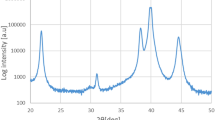Abstract
In this paper, we propose a three-axis pneumatic tactile display that is precisely controlled by using integrated capacitive displacement sensors. The proposed tactile display consists of a core body with a 3 × 3 balloon array on its top surface, four lateral balloons made of latex rubber, and inner and outer frames that include capacitive displacement sensors based on a flexible printed circuit board. The 3 × 3 balloon array on the core body is designed to apply normal haptic stimulation to a human fingertip. In addition, the lateral motions of the core body and each frame produce haptic stimulation in a tangential direction. Precise control of lateral motion was achieved by feedback control using the capacitive displacement sensors. The size of the fabricated tactile display was 26 × 26 × 18 mm3. We experimentally performed manipulation of the proposed device with a custom control system, thereby demonstrating accurate control of displacement.










Similar content being viewed by others
References
Ballantyne G (2002) Robotic surgery, telerobotic surgery, telepresence, and telementoring: review of early clinical results. Surg Endosc 16(10):1389–1402
Bark K, Mcmahan W, Remington A, Gewirtz J, Wedmid A, Lee DI, Kuchenbecker KJ (2013) In vivo validation of a system for haptic feedback of tool vibrations in robotic surgery. Surg Endosc 27(2):656–664
Baxter LK (1997) Capacitive sensors. IEEE Press, New York
Bethea B, Okamura A, Kitagawa M, Fitton T, Cattaneo S, Gott V, Baumgartner W, Yuh D (2004) Application of haptic feedback to robotic surgery. J Laparoendosc Adv Surg Tech 14(3):191–195
Corcione F, Esposito C, Cuccurullo D, Settembre A, Miranda N, Amato F, Pirozzi F, Caiazzo P (2005) Advantages and limits of robot-assisted laparoscopic surgery: preliminary experience. Surg Endosc 19(1):117–119
Culjat M, King C, Franco M, Bisley J, Grundfest W, Dutson E (2008) Pneumatic balloon actuators for tactile feedback in robotic surgery. Ind Robot Int J 35(5):449–455
Dargahi J, Najarian S (2003) An endoscopic force-position sensor grasper with minimum sensors. Can J Electr Comput Eng 28(3/4):155–161
Dargahi J, Najarian S, Ramezanifard R (2007) Graphical display of tactile sensing data with application in minimally invasive surgery. Can J Electr Comput Eng 32(3):151–155
Doh E, Yoo J, Lee H, Park J, Yun K (2013) Microfabrication of three-axis tactile feedback actuator for robot-assisted surgery. Jpn J Appl Phys 52:017302
Hashizume M, Shimada M, Tomikawa M, Ikeda Y, Takahashi I, Abe R, Koga F, Gotoh N, Konishi K, Maehara S, Sugimachi K (2002) Early experiences of endoscopic procedures in general surgery assisted by a computer-enhanced surgical system. Surg Endosc 16(8):1187–1191
Kim D, Kim B, Kang H (2004) Development of a piezoelectric polymer-based sensorized microgripper for microassembly and micromanipulation. Microsyst Technol 10(4):275–280
King C, Franco M, Culjat M, Higa A, Bisley J, Dutson E, Grundfest W (2008) Fabrication and characterization of a balloon actuator array for haptic feedback in robotic surgery. J Med Devices 2(4):041006
Kornprat P, Werkgartner G, Cerwenka H, Bacher H, El-Shabrawi A, Rehak P, Mischinger HJ (2006) Prospective study comparing standard and robotically assisted laparoscopic cholecystectomy. Langenbecks Arch Surg 391(3):216–221
Lamata P, Gómez E, Sánchez-Margallo F, Lamata F, Del Pozo F, Usón J (2006) Tissue consistency perception in laparoscopy to define the level of fidelity in virtual reality simulation. Surg Endosc 20(9):1368–1375
Lanfranco A, Castellanos A, Desai J, Meyers W (2004) Robotic surgery: a current perspective. Ann Surg 239(1):14–21
Lim SC, Lee H, Doh E, Yun K, Park J (2014) Tactile display with tangential and normal skin displacement for robot assisted surgery. Adv Robotics 28(13):859–868
Moradi Dalvand M, Shirinzadeh B, Nahavandi S, Smith J (2014a) Effects of realistic force feedback in a robotic assisted minimally invasive surgery system. Minim Invasive Ther Allied Technol 23(3):127–135
Moradi Dalvand M, Shirinzadeh B, Shamdani AH, Smith J, Zhong Y (2014b) An actuated force feedback-enabled laparoscopic instrument for robotic-assisted surgery. Int J Med Robot 10(1):11–21
Morino M, Pellegrino L, Giaccone C, Garrone C, Rebecchi F (2006) Randomized clinical trial of robot-assisted versus laparoscopic Nissen fundoplication. Br J Surg 93(5):553–558
Muller-Stich B, Reiter M, Wente M, Bintintan V, Koninger J, Buchler M, Gutt C (2007) Robot-assisted versus conventional laparoscopic fundoplication: short-term outcome of a pilot randomized controlled trial. Surg Endosc 21(10):1800–1805
Nguan C, Girvan A, Luke P (2008) Robotic surgery versus laparoscopy; a comparison between two robotic systems and laparoscopy. J Robot Surg 1(4):263–268
Ottermo MV, Stavdahl Ø, Johansen TA (2008) Design and performance of a prototype tactile shape display for minimally invasive surgery. Haptics-E J 4(4):1–13
Reiley CE, Akinbiyi T, Burschka D, Chang DC, Okamura AM, Yuh DD (2008) Effects of visual force feedback on robot-assisted surgical task performance. J Thorac Cardiovasc Surg 135(1):196–202
Schreuder H, Verheijen R (2009) Robotic surgery. BJOG Int J Obstet Gynecol 116(2):198–213
Sung GT, Gill IS (2001) Robotic laparoscopic surgery: a comparison of the da Vinci and Zeus systems. Urology 58(6):893–898
Tholey G, Desai JP, Castellanos AE (2005) Force feedback plays a significant role in minimally invasive surgery: results and analysis. Ann Surg 241(1):102
Wottawa CR, Cohen JR, Fan RE, Bisley JW, Culjat MO, Grundfest WS, Dutson EP (2013) The role of tactile feedback in grip force during laparoscopic training tasks. Surg Endosc 27(4):1111–1118
Yoo J, Yun S, Ahn Y, Lee H, Lim S, Park J, Yun K (2014) Feedback control of pneumatic tactile actuator using capacitive displacement sensor. In: The 16th Korean MEMS conference, pp 155–156
Acknowledgments
This work was supported by Samsung Advanced Institute of Technology.
Author information
Authors and Affiliations
Corresponding author
Additional information
S. Yun and J. Yoo contributed equally to this work.
Rights and permissions
About this article
Cite this article
Yun, S., Yoo, J., Lim, S. et al. Three-axis pneumatic tactile display with integrated capacitive sensors for feedback control. Microsyst Technol 22, 275–282 (2016). https://doi.org/10.1007/s00542-014-2388-0
Received:
Accepted:
Published:
Issue Date:
DOI: https://doi.org/10.1007/s00542-014-2388-0




